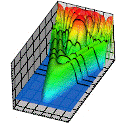Department of Physics and Astronomy: Publications and Other Research

Anthony F. Starace Publications
Document Type
Article
Date of this Version
9-2012
Citation
New Journal of Physics 14 (2012) 095010 (20pp); doi:10.1088/1367-2630/14/9/095010
Online at http://www.njp.org/
Abstract
By solving the two-active-electron, time-dependent Schrödinger equation in its full dimensionality, we investigate the carrier-envelope phase (CEP) dependence of single ionization of He to the He+(1s) state triggered by an intense few-cycle attosecond pulse with carrier frequency ω corresponding to the energy ћω = 36 eV. Effects of electron correlations are probed by comparing projections of the final state of the two-electron wave packet onto field-free highly correlated Jacobi matrix wave functions with projections onto uncorrelated Coulomb wave functions. Significant differences are found in the vicinity of autoionizing resonances. Owing to the broad bandwidths of our 115 and 230 as pulses and their high intensities (1–2 PWcm−2), asymmetries are found in the differential probability for ionization of electrons parallel and antiparallel to the linear polarization axis of the laser pulse. These asymmetries stem from interference of the one- and two-photon ionization amplitudes for producing electrons with the same momentum along the linear polarization axis. Whereas these asymmetries generally decrease with increasing ionized electron kinetic energy, we find a large enhancement of the asymmetry in the vicinity of two-electron doubly excited (autoionizing) states on an energy scale comparable to the widths of the autoionizing states. The CEP dependence of the energy-integrated asymmetry agrees very well with the predictions of time-dependent perturbation theory (Pronin et al 2009 Phys. Rev. A 80 063403).


Comments
© IOP Publishing Ltd and Deutsche Physikalische Gesellschaft. Content from this work may be used under the terms of the Creative Commons Attribution-NonCommercial- ShareAlike 3.0 licence.